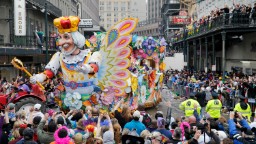Mardi Gras Fast Facts | CNN


CNN
—
Here’s a look at Mardi Gras, a celebration held the day before the fasting season of Lent begins on Ash Wednesday.
March 1, 2022 – Mardi Gras (Fat Tuesday).
January 6 – Carnival season celebrations begin on this date each year, continuing through midnight on Fat Tuesday.
Mardi Gras, French for Fat Tuesday, is also known as Shrove Tuesday.
Mardi Gras Day is the last day of Carnival season.
Carnivals include balls, parties and parades with floats and costumed dancers.
The colors of Mardi Gras are purple (justice), gold (power) and green (faith).
Social clubs called “Krewes” organize the parades, and host balls and parties.
During parades, krewe members throw a variety of trinkets to spectators, which can include beaded necklaces, doubloons, cups, and stuffed animals.
Separate from krewes, street parades by Mardi Gras Indians, Baby Dolls and the Northside Skull and Bone Gang are long-standing Black Carnival traditions in New Orleans.
Mardi Gras is a holiday in 29 Louisiana parishes and two counties in Alabama. It’s a holiday in Florida for any counties with carnival associations and can be declared a holiday in lieu of another state holiday by counties in Mississippi.
1703 – The first Mardi Gras celebration is held in Mobile, Alabama.
1837 – First recorded Mardi Gras parade in New Orleans.
1857 – First time floats appear in New Orleans parades.
1896 – The first female krewe, Les Mysterieuses, stages a ball but does not parade.
1916 – The Zulu Social Aid and Pleasure Club, the first African American krewe, is incorporated.
1918-1919 – Mardi Gras parades and balls are canceled due to World War I and the influenza pandemic.
1941 – Venus is the first all-female krewe to parade in New Orleans.
1942-1945 – Official Mardi Gras festivities are canceled for the duration of World War II.
1973 – Zulu becomes the first parading krewe to racially integrate its membership.
1992 – New Orleans city council passes an ordinance banning discrimination in the membership of parading Mardi Gras krewes. Three krewes discontinue their parades in protest of the push to integrate.
2004 – Conde Explorers become the first integrated parading society in Mobile.
2017-2018 – Due to excessive flooding and clogged storm drains, the city of New Orleans removes more than 93,000 pounds of Mardi Gras beads from a five-block stretch of the city’s drains. Prior to the 2019 Mardi Gras celebration, the city installs “gutter buddies” to prevent beads from entering the drains.
2021 – Mardi Gras parades are not permitted due to the coronavirus pandemic, but since Mardi Gras is a religious holiday, it can’t be canceled. According to the Krew of House Floats’ website, more than 2,600 New Orleans residents join the Krewe of House Floats, turning their homes into stationary versions of parade floats as a way to celebrate safely.







